Chemotherapy-induced nausea and vomiting
VerifiedAdded on 2022/09/18
|12
|3342
|20
AI Summary
Contribute Materials
Your contribution can guide someone’s learning journey. Share your
documents today.
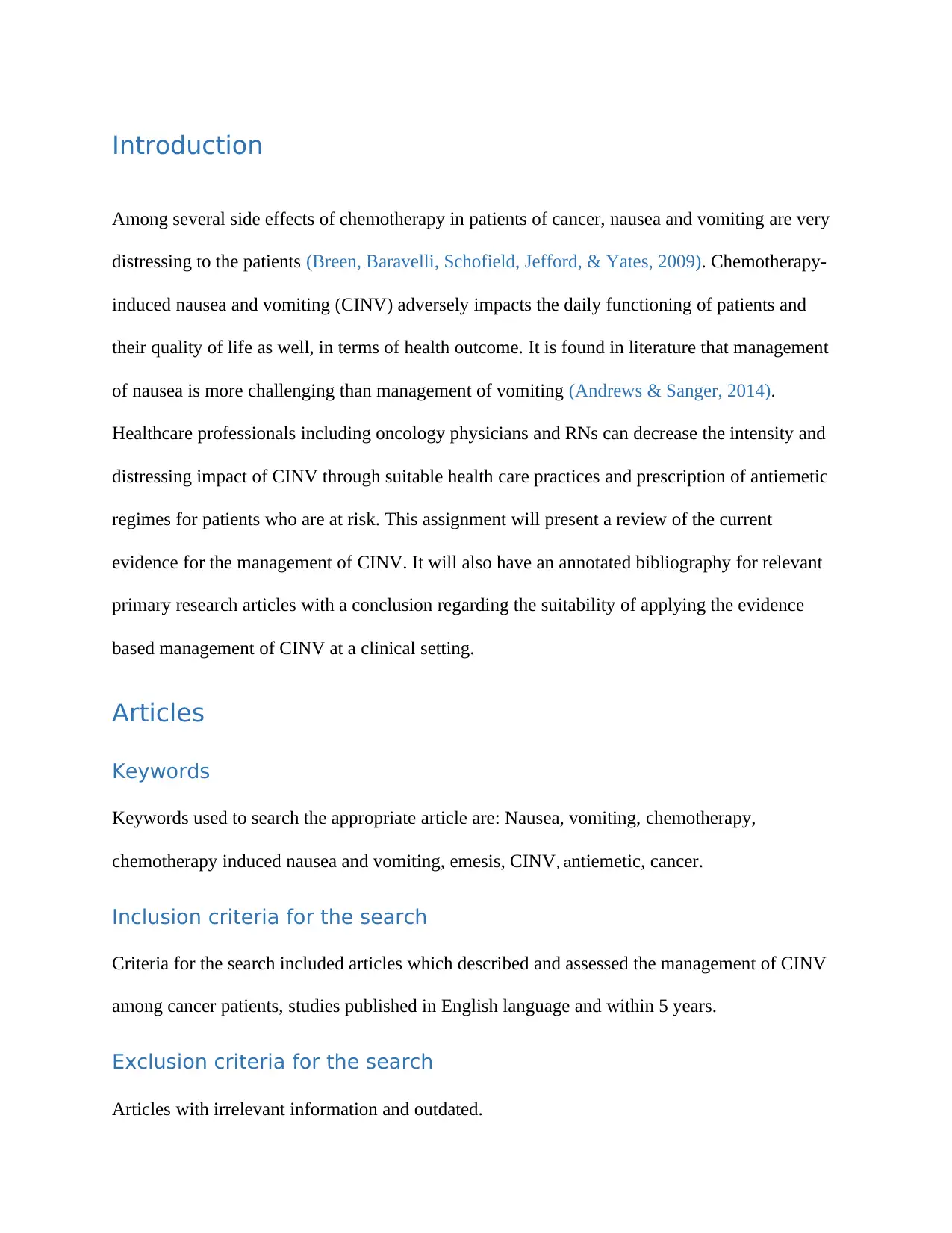
Introduction
Among several side effects of chemotherapy in patients of cancer, nausea and vomiting are very
distressing to the patients (Breen, Baravelli, Schofield, Jefford, & Yates, 2009). Chemotherapy-
induced nausea and vomiting (CINV) adversely impacts the daily functioning of patients and
their quality of life as well, in terms of health outcome. It is found in literature that management
of nausea is more challenging than management of vomiting (Andrews & Sanger, 2014).
Healthcare professionals including oncology physicians and RNs can decrease the intensity and
distressing impact of CINV through suitable health care practices and prescription of antiemetic
regimes for patients who are at risk. This assignment will present a review of the current
evidence for the management of CINV. It will also have an annotated bibliography for relevant
primary research articles with a conclusion regarding the suitability of applying the evidence
based management of CINV at a clinical setting.
Articles
Keywords
Keywords used to search the appropriate article are: Nausea, vomiting, chemotherapy,
chemotherapy induced nausea and vomiting, emesis, CINV, antiemetic, cancer.
Inclusion criteria for the search
Criteria for the search included articles which described and assessed the management of CINV
among cancer patients, studies published in English language and within 5 years.
Exclusion criteria for the search
Articles with irrelevant information and outdated.
Among several side effects of chemotherapy in patients of cancer, nausea and vomiting are very
distressing to the patients (Breen, Baravelli, Schofield, Jefford, & Yates, 2009). Chemotherapy-
induced nausea and vomiting (CINV) adversely impacts the daily functioning of patients and
their quality of life as well, in terms of health outcome. It is found in literature that management
of nausea is more challenging than management of vomiting (Andrews & Sanger, 2014).
Healthcare professionals including oncology physicians and RNs can decrease the intensity and
distressing impact of CINV through suitable health care practices and prescription of antiemetic
regimes for patients who are at risk. This assignment will present a review of the current
evidence for the management of CINV. It will also have an annotated bibliography for relevant
primary research articles with a conclusion regarding the suitability of applying the evidence
based management of CINV at a clinical setting.
Articles
Keywords
Keywords used to search the appropriate article are: Nausea, vomiting, chemotherapy,
chemotherapy induced nausea and vomiting, emesis, CINV, antiemetic, cancer.
Inclusion criteria for the search
Criteria for the search included articles which described and assessed the management of CINV
among cancer patients, studies published in English language and within 5 years.
Exclusion criteria for the search
Articles with irrelevant information and outdated.
Secure Best Marks with AI Grader
Need help grading? Try our AI Grader for instant feedback on your assignments.
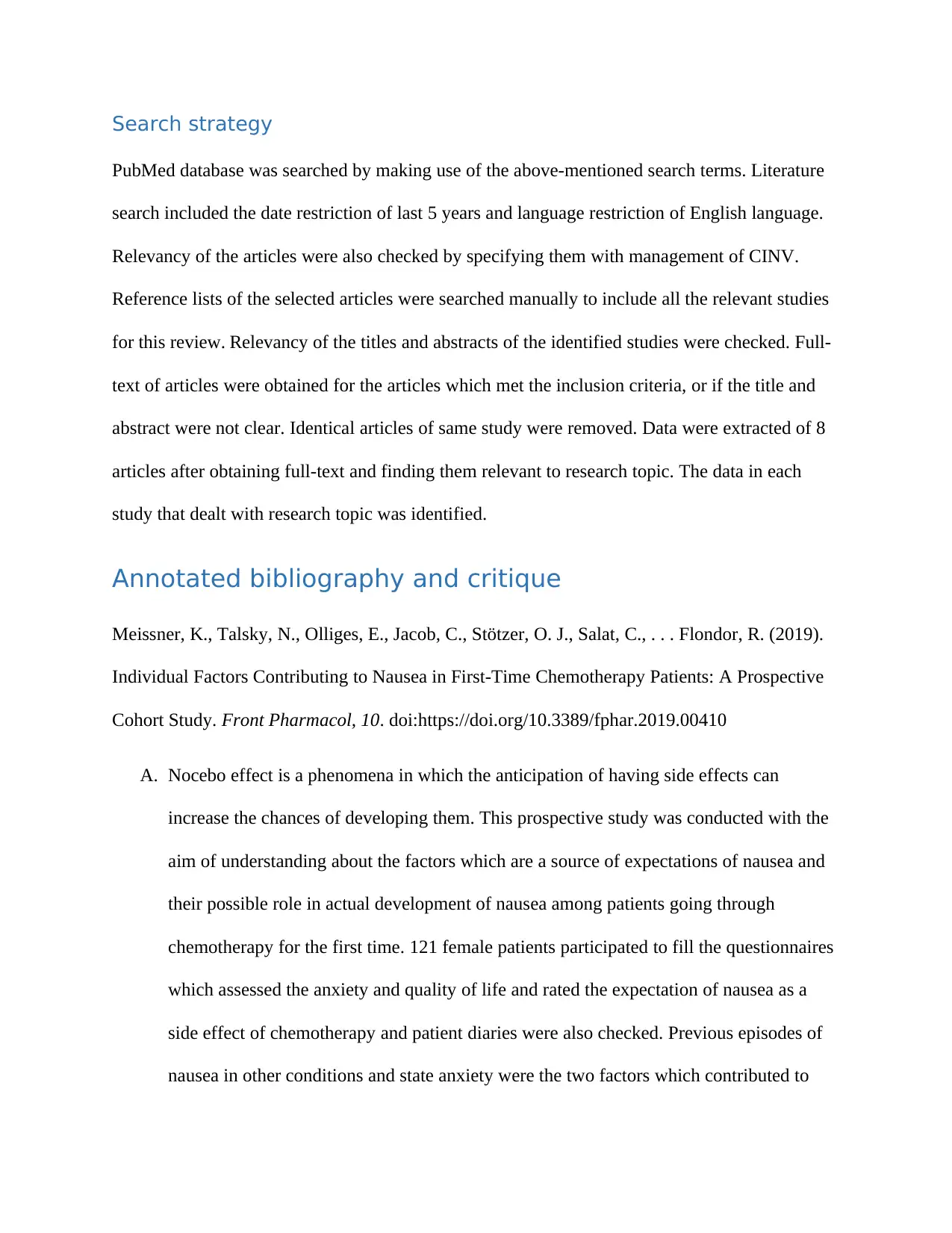
Search strategy
PubMed database was searched by making use of the above-mentioned search terms. Literature
search included the date restriction of last 5 years and language restriction of English language.
Relevancy of the articles were also checked by specifying them with management of CINV.
Reference lists of the selected articles were searched manually to include all the relevant studies
for this review. Relevancy of the titles and abstracts of the identified studies were checked. Full-
text of articles were obtained for the articles which met the inclusion criteria, or if the title and
abstract were not clear. Identical articles of same study were removed. Data were extracted of 8
articles after obtaining full-text and finding them relevant to research topic. The data in each
study that dealt with research topic was identified.
Annotated bibliography and critique
Meissner, K., Talsky, N., Olliges, E., Jacob, C., Stötzer, O. J., Salat, C., . . . Flondor, R. (2019).
Individual Factors Contributing to Nausea in First-Time Chemotherapy Patients: A Prospective
Cohort Study. Front Pharmacol, 10. doi:https://doi.org/10.3389/fphar.2019.00410
A. Nocebo effect is a phenomena in which the anticipation of having side effects can
increase the chances of developing them. This prospective study was conducted with the
aim of understanding about the factors which are a source of expectations of nausea and
their possible role in actual development of nausea among patients going through
chemotherapy for the first time. 121 female patients participated to fill the questionnaires
which assessed the anxiety and quality of life and rated the expectation of nausea as a
side effect of chemotherapy and patient diaries were also checked. Previous episodes of
nausea in other conditions and state anxiety were the two factors which contributed to
PubMed database was searched by making use of the above-mentioned search terms. Literature
search included the date restriction of last 5 years and language restriction of English language.
Relevancy of the articles were also checked by specifying them with management of CINV.
Reference lists of the selected articles were searched manually to include all the relevant studies
for this review. Relevancy of the titles and abstracts of the identified studies were checked. Full-
text of articles were obtained for the articles which met the inclusion criteria, or if the title and
abstract were not clear. Identical articles of same study were removed. Data were extracted of 8
articles after obtaining full-text and finding them relevant to research topic. The data in each
study that dealt with research topic was identified.
Annotated bibliography and critique
Meissner, K., Talsky, N., Olliges, E., Jacob, C., Stötzer, O. J., Salat, C., . . . Flondor, R. (2019).
Individual Factors Contributing to Nausea in First-Time Chemotherapy Patients: A Prospective
Cohort Study. Front Pharmacol, 10. doi:https://doi.org/10.3389/fphar.2019.00410
A. Nocebo effect is a phenomena in which the anticipation of having side effects can
increase the chances of developing them. This prospective study was conducted with the
aim of understanding about the factors which are a source of expectations of nausea and
their possible role in actual development of nausea among patients going through
chemotherapy for the first time. 121 female patients participated to fill the questionnaires
which assessed the anxiety and quality of life and rated the expectation of nausea as a
side effect of chemotherapy and patient diaries were also checked. Previous episodes of
nausea in other conditions and state anxiety were the two factors which contributed to
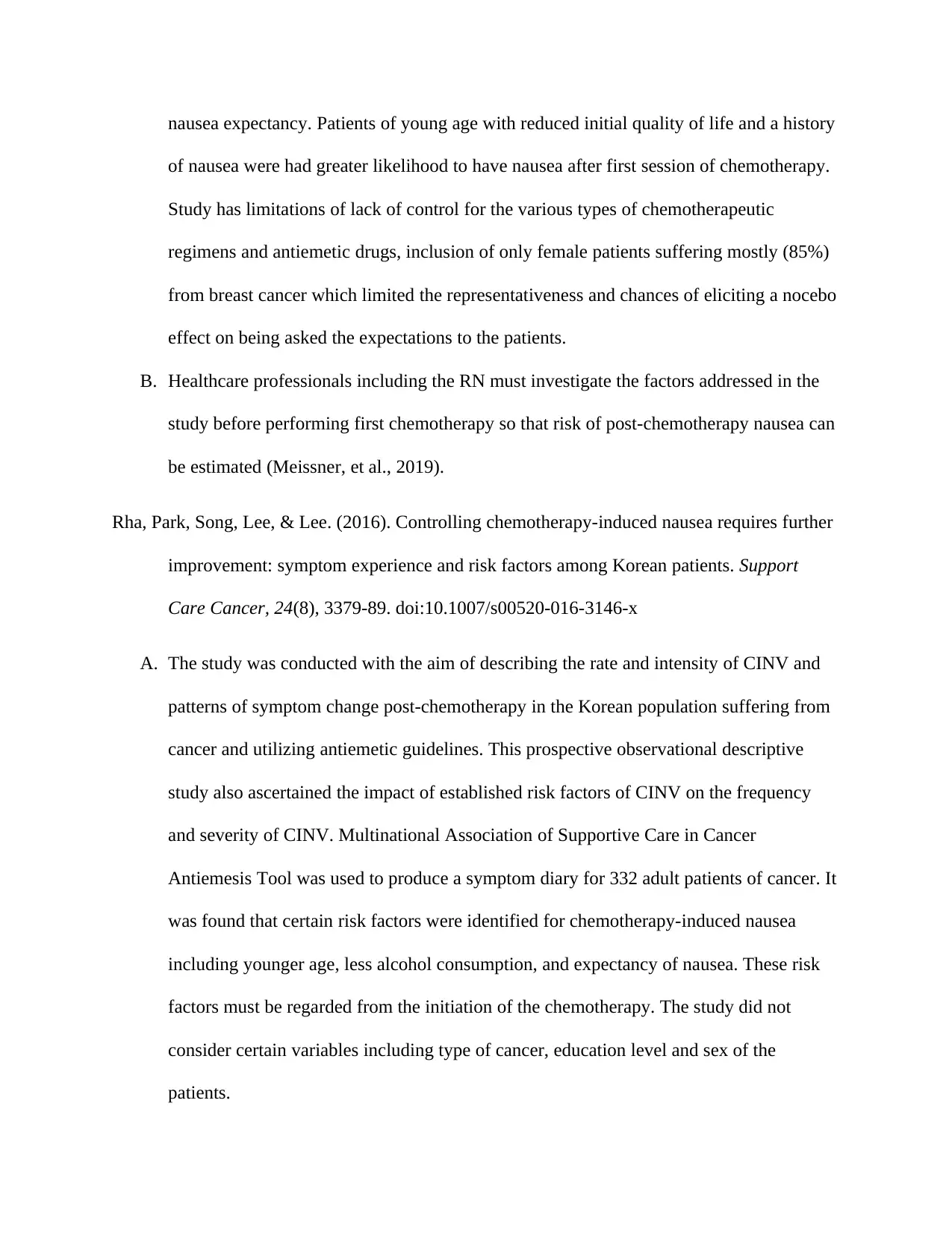
nausea expectancy. Patients of young age with reduced initial quality of life and a history
of nausea were had greater likelihood to have nausea after first session of chemotherapy.
Study has limitations of lack of control for the various types of chemotherapeutic
regimens and antiemetic drugs, inclusion of only female patients suffering mostly (85%)
from breast cancer which limited the representativeness and chances of eliciting a nocebo
effect on being asked the expectations to the patients.
B. Healthcare professionals including the RN must investigate the factors addressed in the
study before performing first chemotherapy so that risk of post-chemotherapy nausea can
be estimated (Meissner, et al., 2019).
Rha, Park, Song, Lee, & Lee. (2016). Controlling chemotherapy-induced nausea requires further
improvement: symptom experience and risk factors among Korean patients. Support
Care Cancer, 24(8), 3379-89. doi:10.1007/s00520-016-3146-x
A. The study was conducted with the aim of describing the rate and intensity of CINV and
patterns of symptom change post-chemotherapy in the Korean population suffering from
cancer and utilizing antiemetic guidelines. This prospective observational descriptive
study also ascertained the impact of established risk factors of CINV on the frequency
and severity of CINV. Multinational Association of Supportive Care in Cancer
Antiemesis Tool was used to produce a symptom diary for 332 adult patients of cancer. It
was found that certain risk factors were identified for chemotherapy-induced nausea
including younger age, less alcohol consumption, and expectancy of nausea. These risk
factors must be regarded from the initiation of the chemotherapy. The study did not
consider certain variables including type of cancer, education level and sex of the
patients.
of nausea were had greater likelihood to have nausea after first session of chemotherapy.
Study has limitations of lack of control for the various types of chemotherapeutic
regimens and antiemetic drugs, inclusion of only female patients suffering mostly (85%)
from breast cancer which limited the representativeness and chances of eliciting a nocebo
effect on being asked the expectations to the patients.
B. Healthcare professionals including the RN must investigate the factors addressed in the
study before performing first chemotherapy so that risk of post-chemotherapy nausea can
be estimated (Meissner, et al., 2019).
Rha, Park, Song, Lee, & Lee. (2016). Controlling chemotherapy-induced nausea requires further
improvement: symptom experience and risk factors among Korean patients. Support
Care Cancer, 24(8), 3379-89. doi:10.1007/s00520-016-3146-x
A. The study was conducted with the aim of describing the rate and intensity of CINV and
patterns of symptom change post-chemotherapy in the Korean population suffering from
cancer and utilizing antiemetic guidelines. This prospective observational descriptive
study also ascertained the impact of established risk factors of CINV on the frequency
and severity of CINV. Multinational Association of Supportive Care in Cancer
Antiemesis Tool was used to produce a symptom diary for 332 adult patients of cancer. It
was found that certain risk factors were identified for chemotherapy-induced nausea
including younger age, less alcohol consumption, and expectancy of nausea. These risk
factors must be regarded from the initiation of the chemotherapy. The study did not
consider certain variables including type of cancer, education level and sex of the
patients.
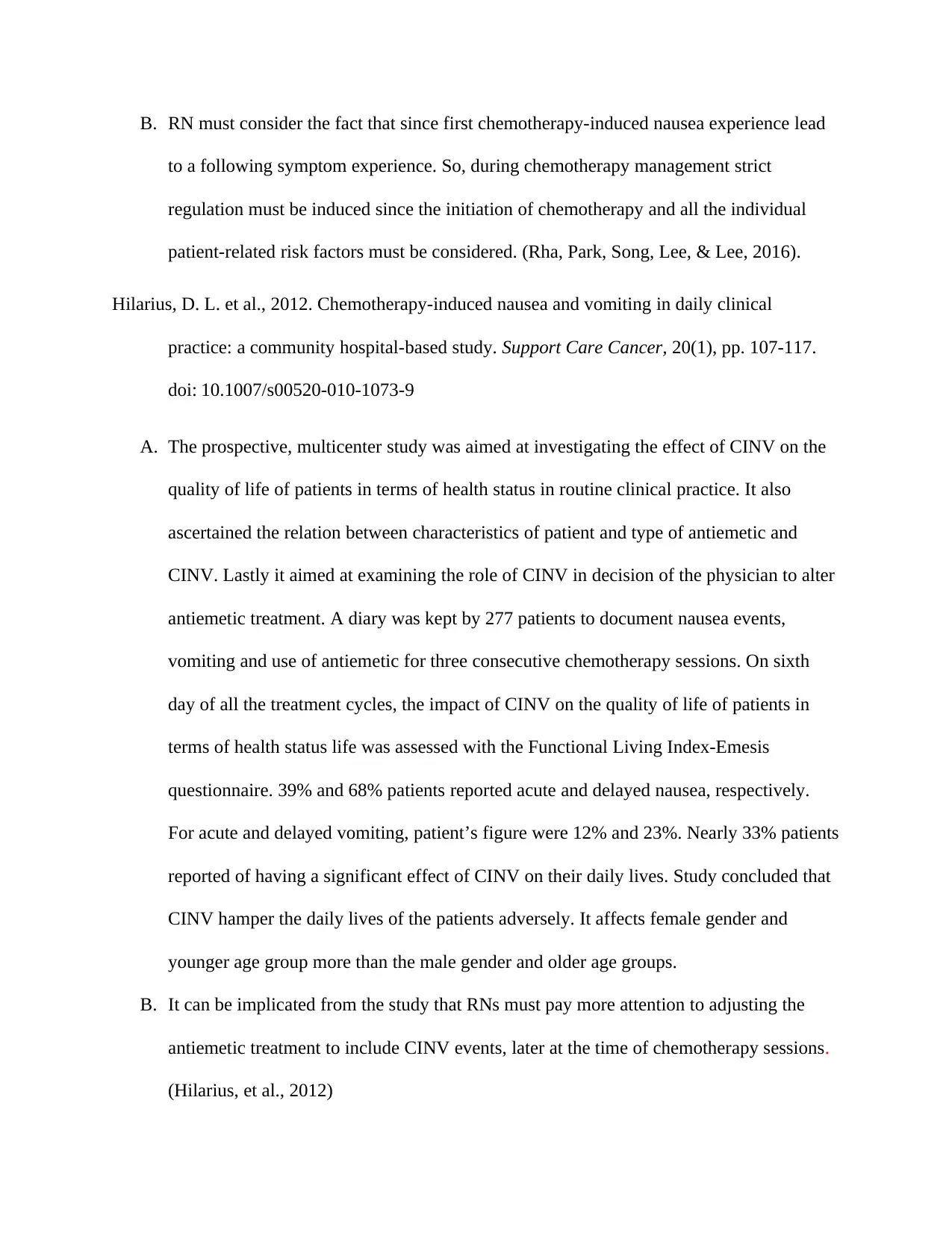
B. RN must consider the fact that since first chemotherapy-induced nausea experience lead
to a following symptom experience. So, during chemotherapy management strict
regulation must be induced since the initiation of chemotherapy and all the individual
patient-related risk factors must be considered. (Rha, Park, Song, Lee, & Lee, 2016).
Hilarius, D. L. et al., 2012. Chemotherapy-induced nausea and vomiting in daily clinical
practice: a community hospital-based study. Support Care Cancer, 20(1), pp. 107-117.
doi: 10.1007/s00520-010-1073-9
A. The prospective, multicenter study was aimed at investigating the effect of CINV on the
quality of life of patients in terms of health status in routine clinical practice. It also
ascertained the relation between characteristics of patient and type of antiemetic and
CINV. Lastly it aimed at examining the role of CINV in decision of the physician to alter
antiemetic treatment. A diary was kept by 277 patients to document nausea events,
vomiting and use of antiemetic for three consecutive chemotherapy sessions. On sixth
day of all the treatment cycles, the impact of CINV on the quality of life of patients in
terms of health status life was assessed with the Functional Living Index-Emesis
questionnaire. 39% and 68% patients reported acute and delayed nausea, respectively.
For acute and delayed vomiting, patient’s figure were 12% and 23%. Nearly 33% patients
reported of having a significant effect of CINV on their daily lives. Study concluded that
CINV hamper the daily lives of the patients adversely. It affects female gender and
younger age group more than the male gender and older age groups.
B. It can be implicated from the study that RNs must pay more attention to adjusting the
antiemetic treatment to include CINV events, later at the time of chemotherapy sessions.
(Hilarius, et al., 2012)
to a following symptom experience. So, during chemotherapy management strict
regulation must be induced since the initiation of chemotherapy and all the individual
patient-related risk factors must be considered. (Rha, Park, Song, Lee, & Lee, 2016).
Hilarius, D. L. et al., 2012. Chemotherapy-induced nausea and vomiting in daily clinical
practice: a community hospital-based study. Support Care Cancer, 20(1), pp. 107-117.
doi: 10.1007/s00520-010-1073-9
A. The prospective, multicenter study was aimed at investigating the effect of CINV on the
quality of life of patients in terms of health status in routine clinical practice. It also
ascertained the relation between characteristics of patient and type of antiemetic and
CINV. Lastly it aimed at examining the role of CINV in decision of the physician to alter
antiemetic treatment. A diary was kept by 277 patients to document nausea events,
vomiting and use of antiemetic for three consecutive chemotherapy sessions. On sixth
day of all the treatment cycles, the impact of CINV on the quality of life of patients in
terms of health status life was assessed with the Functional Living Index-Emesis
questionnaire. 39% and 68% patients reported acute and delayed nausea, respectively.
For acute and delayed vomiting, patient’s figure were 12% and 23%. Nearly 33% patients
reported of having a significant effect of CINV on their daily lives. Study concluded that
CINV hamper the daily lives of the patients adversely. It affects female gender and
younger age group more than the male gender and older age groups.
B. It can be implicated from the study that RNs must pay more attention to adjusting the
antiemetic treatment to include CINV events, later at the time of chemotherapy sessions.
(Hilarius, et al., 2012)
Secure Best Marks with AI Grader
Need help grading? Try our AI Grader for instant feedback on your assignments.
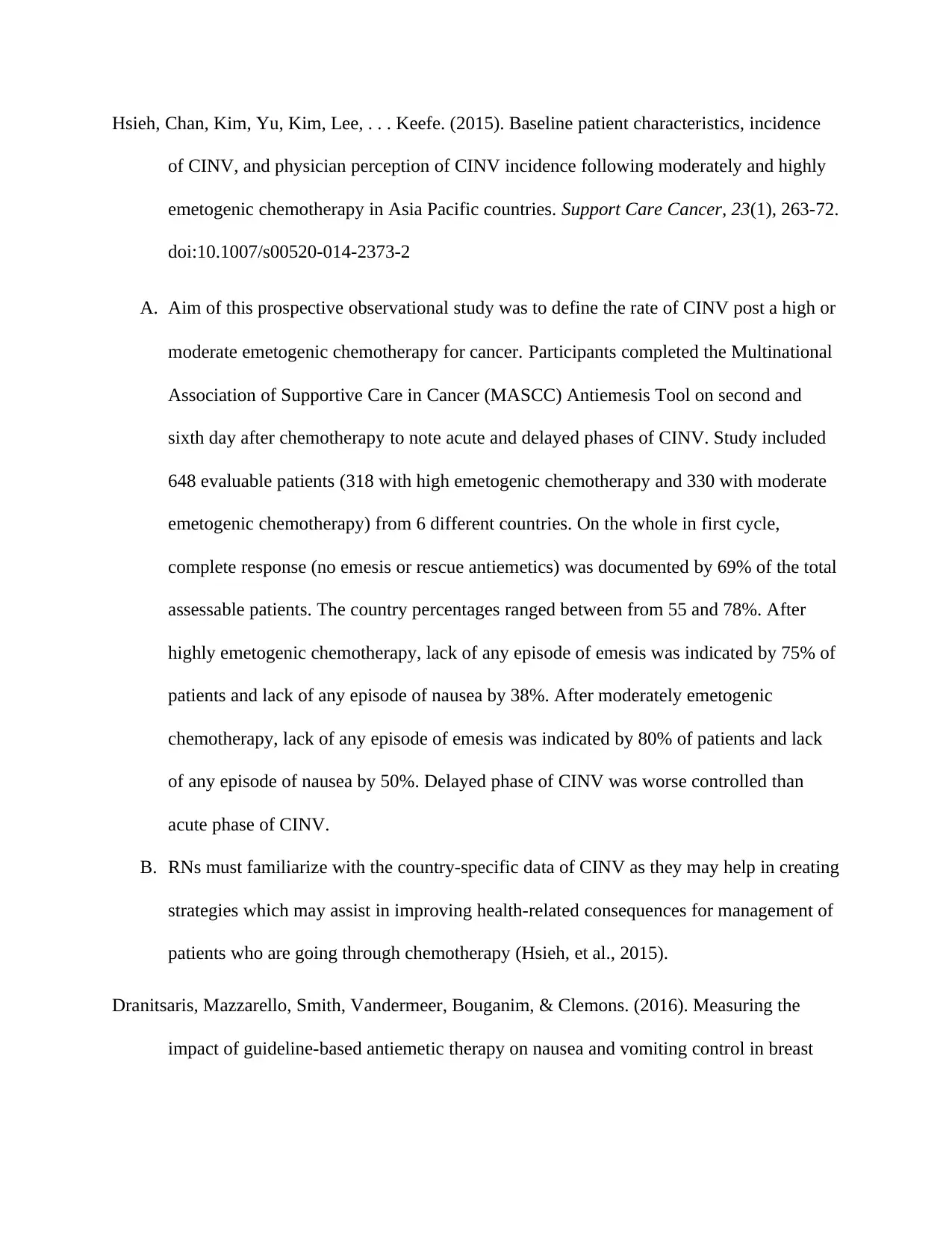
Hsieh, Chan, Kim, Yu, Kim, Lee, . . . Keefe. (2015). Baseline patient characteristics, incidence
of CINV, and physician perception of CINV incidence following moderately and highly
emetogenic chemotherapy in Asia Pacific countries. Support Care Cancer, 23(1), 263-72.
doi:10.1007/s00520-014-2373-2
A. Aim of this prospective observational study was to define the rate of CINV post a high or
moderate emetogenic chemotherapy for cancer. Participants completed the Multinational
Association of Supportive Care in Cancer (MASCC) Antiemesis Tool on second and
sixth day after chemotherapy to note acute and delayed phases of CINV. Study included
648 evaluable patients (318 with high emetogenic chemotherapy and 330 with moderate
emetogenic chemotherapy) from 6 different countries. On the whole in first cycle,
complete response (no emesis or rescue antiemetics) was documented by 69% of the total
assessable patients. The country percentages ranged between from 55 and 78%. After
highly emetogenic chemotherapy, lack of any episode of emesis was indicated by 75% of
patients and lack of any episode of nausea by 38%. After moderately emetogenic
chemotherapy, lack of any episode of emesis was indicated by 80% of patients and lack
of any episode of nausea by 50%. Delayed phase of CINV was worse controlled than
acute phase of CINV.
B. RNs must familiarize with the country-specific data of CINV as they may help in creating
strategies which may assist in improving health-related consequences for management of
patients who are going through chemotherapy (Hsieh, et al., 2015).
Dranitsaris, Mazzarello, Smith, Vandermeer, Bouganim, & Clemons. (2016). Measuring the
impact of guideline-based antiemetic therapy on nausea and vomiting control in breast
of CINV, and physician perception of CINV incidence following moderately and highly
emetogenic chemotherapy in Asia Pacific countries. Support Care Cancer, 23(1), 263-72.
doi:10.1007/s00520-014-2373-2
A. Aim of this prospective observational study was to define the rate of CINV post a high or
moderate emetogenic chemotherapy for cancer. Participants completed the Multinational
Association of Supportive Care in Cancer (MASCC) Antiemesis Tool on second and
sixth day after chemotherapy to note acute and delayed phases of CINV. Study included
648 evaluable patients (318 with high emetogenic chemotherapy and 330 with moderate
emetogenic chemotherapy) from 6 different countries. On the whole in first cycle,
complete response (no emesis or rescue antiemetics) was documented by 69% of the total
assessable patients. The country percentages ranged between from 55 and 78%. After
highly emetogenic chemotherapy, lack of any episode of emesis was indicated by 75% of
patients and lack of any episode of nausea by 38%. After moderately emetogenic
chemotherapy, lack of any episode of emesis was indicated by 80% of patients and lack
of any episode of nausea by 50%. Delayed phase of CINV was worse controlled than
acute phase of CINV.
B. RNs must familiarize with the country-specific data of CINV as they may help in creating
strategies which may assist in improving health-related consequences for management of
patients who are going through chemotherapy (Hsieh, et al., 2015).
Dranitsaris, Mazzarello, Smith, Vandermeer, Bouganim, & Clemons. (2016). Measuring the
impact of guideline-based antiemetic therapy on nausea and vomiting control in breast
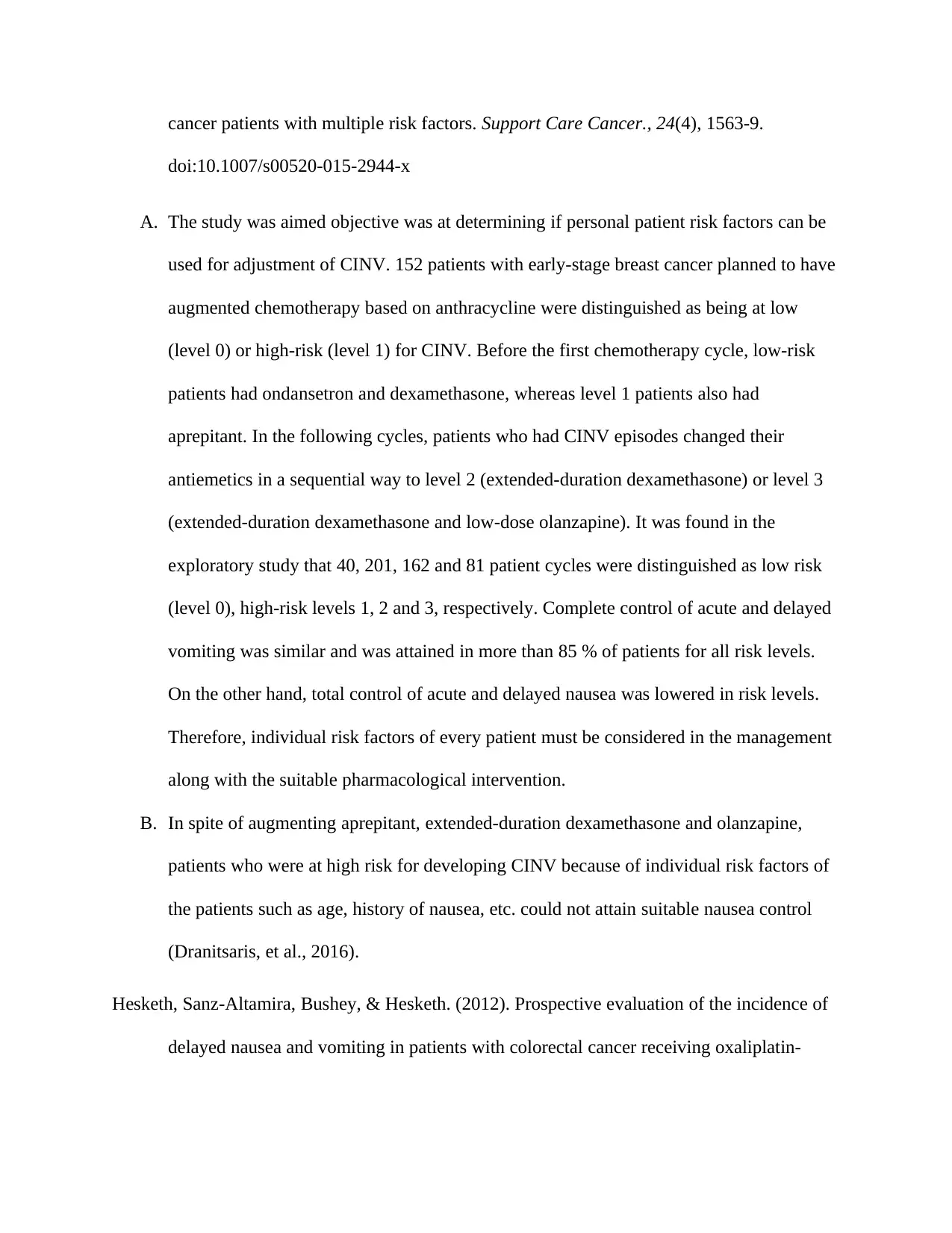
cancer patients with multiple risk factors. Support Care Cancer., 24(4), 1563-9.
doi:10.1007/s00520-015-2944-x
A. The study was aimed objective was at determining if personal patient risk factors can be
used for adjustment of CINV. 152 patients with early-stage breast cancer planned to have
augmented chemotherapy based on anthracycline were distinguished as being at low
(level 0) or high-risk (level 1) for CINV. Before the first chemotherapy cycle, low-risk
patients had ondansetron and dexamethasone, whereas level 1 patients also had
aprepitant. In the following cycles, patients who had CINV episodes changed their
antiemetics in a sequential way to level 2 (extended-duration dexamethasone) or level 3
(extended-duration dexamethasone and low-dose olanzapine). It was found in the
exploratory study that 40, 201, 162 and 81 patient cycles were distinguished as low risk
(level 0), high-risk levels 1, 2 and 3, respectively. Complete control of acute and delayed
vomiting was similar and was attained in more than 85 % of patients for all risk levels.
On the other hand, total control of acute and delayed nausea was lowered in risk levels.
Therefore, individual risk factors of every patient must be considered in the management
along with the suitable pharmacological intervention.
B. In spite of augmenting aprepitant, extended-duration dexamethasone and olanzapine,
patients who were at high risk for developing CINV because of individual risk factors of
the patients such as age, history of nausea, etc. could not attain suitable nausea control
(Dranitsaris, et al., 2016).
Hesketh, Sanz-Altamira, Bushey, & Hesketh. (2012). Prospective evaluation of the incidence of
delayed nausea and vomiting in patients with colorectal cancer receiving oxaliplatin-
doi:10.1007/s00520-015-2944-x
A. The study was aimed objective was at determining if personal patient risk factors can be
used for adjustment of CINV. 152 patients with early-stage breast cancer planned to have
augmented chemotherapy based on anthracycline were distinguished as being at low
(level 0) or high-risk (level 1) for CINV. Before the first chemotherapy cycle, low-risk
patients had ondansetron and dexamethasone, whereas level 1 patients also had
aprepitant. In the following cycles, patients who had CINV episodes changed their
antiemetics in a sequential way to level 2 (extended-duration dexamethasone) or level 3
(extended-duration dexamethasone and low-dose olanzapine). It was found in the
exploratory study that 40, 201, 162 and 81 patient cycles were distinguished as low risk
(level 0), high-risk levels 1, 2 and 3, respectively. Complete control of acute and delayed
vomiting was similar and was attained in more than 85 % of patients for all risk levels.
On the other hand, total control of acute and delayed nausea was lowered in risk levels.
Therefore, individual risk factors of every patient must be considered in the management
along with the suitable pharmacological intervention.
B. In spite of augmenting aprepitant, extended-duration dexamethasone and olanzapine,
patients who were at high risk for developing CINV because of individual risk factors of
the patients such as age, history of nausea, etc. could not attain suitable nausea control
(Dranitsaris, et al., 2016).
Hesketh, Sanz-Altamira, Bushey, & Hesketh. (2012). Prospective evaluation of the incidence of
delayed nausea and vomiting in patients with colorectal cancer receiving oxaliplatin-
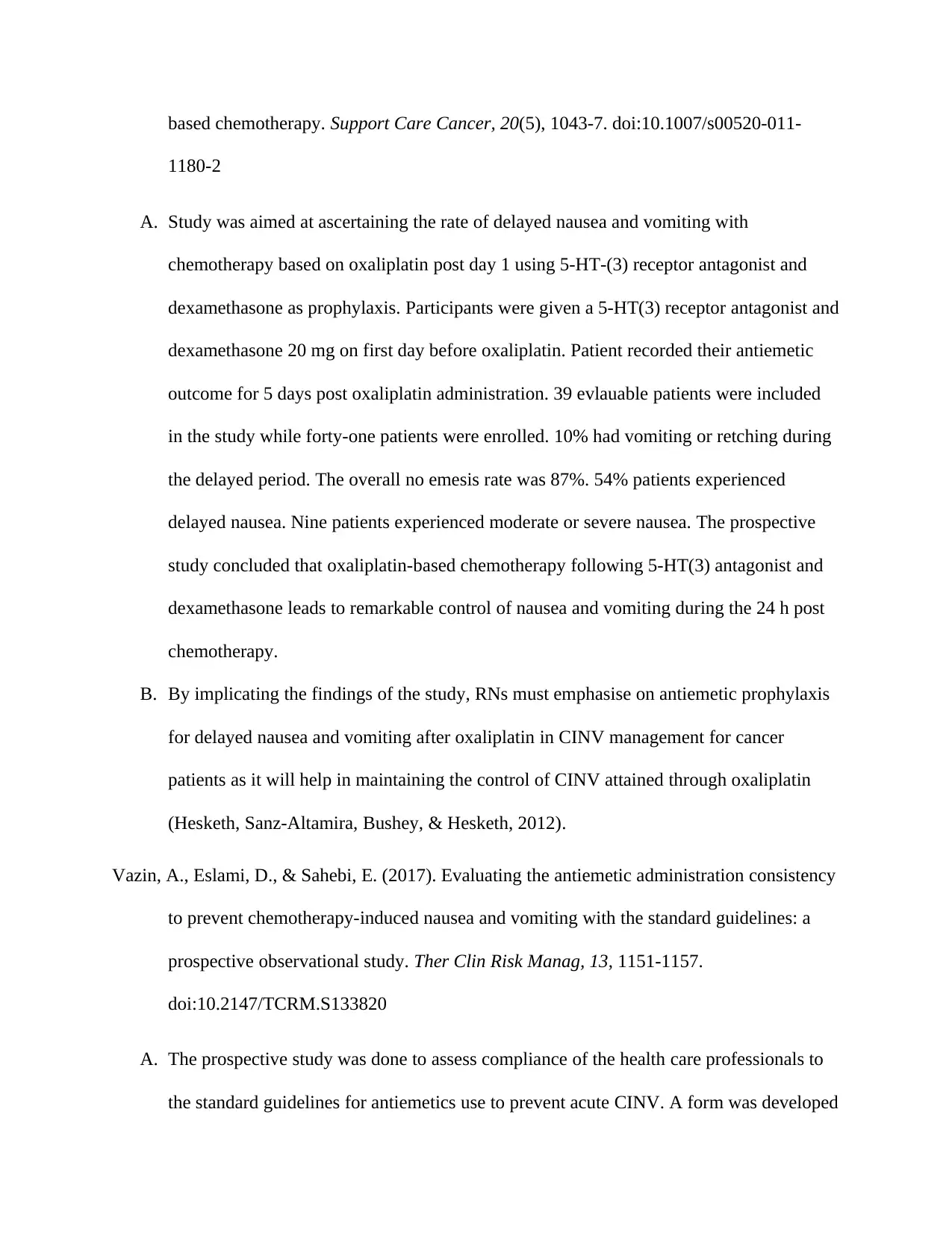
based chemotherapy. Support Care Cancer, 20(5), 1043-7. doi:10.1007/s00520-011-
1180-2
A. Study was aimed at ascertaining the rate of delayed nausea and vomiting with
chemotherapy based on oxaliplatin post day 1 using 5-HT-(3) receptor antagonist and
dexamethasone as prophylaxis. Participants were given a 5-HT(3) receptor antagonist and
dexamethasone 20 mg on first day before oxaliplatin. Patient recorded their antiemetic
outcome for 5 days post oxaliplatin administration. 39 evlauable patients were included
in the study while forty-one patients were enrolled. 10% had vomiting or retching during
the delayed period. The overall no emesis rate was 87%. 54% patients experienced
delayed nausea. Nine patients experienced moderate or severe nausea. The prospective
study concluded that oxaliplatin-based chemotherapy following 5-HT(3) antagonist and
dexamethasone leads to remarkable control of nausea and vomiting during the 24 h post
chemotherapy.
B. By implicating the findings of the study, RNs must emphasise on antiemetic prophylaxis
for delayed nausea and vomiting after oxaliplatin in CINV management for cancer
patients as it will help in maintaining the control of CINV attained through oxaliplatin
(Hesketh, Sanz-Altamira, Bushey, & Hesketh, 2012).
Vazin, A., Eslami, D., & Sahebi, E. (2017). Evaluating the antiemetic administration consistency
to prevent chemotherapy-induced nausea and vomiting with the standard guidelines: a
prospective observational study. Ther Clin Risk Manag, 13, 1151-1157.
doi:10.2147/TCRM.S133820
A. The prospective study was done to assess compliance of the health care professionals to
the standard guidelines for antiemetics use to prevent acute CINV. A form was developed
1180-2
A. Study was aimed at ascertaining the rate of delayed nausea and vomiting with
chemotherapy based on oxaliplatin post day 1 using 5-HT-(3) receptor antagonist and
dexamethasone as prophylaxis. Participants were given a 5-HT(3) receptor antagonist and
dexamethasone 20 mg on first day before oxaliplatin. Patient recorded their antiemetic
outcome for 5 days post oxaliplatin administration. 39 evlauable patients were included
in the study while forty-one patients were enrolled. 10% had vomiting or retching during
the delayed period. The overall no emesis rate was 87%. 54% patients experienced
delayed nausea. Nine patients experienced moderate or severe nausea. The prospective
study concluded that oxaliplatin-based chemotherapy following 5-HT(3) antagonist and
dexamethasone leads to remarkable control of nausea and vomiting during the 24 h post
chemotherapy.
B. By implicating the findings of the study, RNs must emphasise on antiemetic prophylaxis
for delayed nausea and vomiting after oxaliplatin in CINV management for cancer
patients as it will help in maintaining the control of CINV attained through oxaliplatin
(Hesketh, Sanz-Altamira, Bushey, & Hesketh, 2012).
Vazin, A., Eslami, D., & Sahebi, E. (2017). Evaluating the antiemetic administration consistency
to prevent chemotherapy-induced nausea and vomiting with the standard guidelines: a
prospective observational study. Ther Clin Risk Manag, 13, 1151-1157.
doi:10.2147/TCRM.S133820
A. The prospective study was done to assess compliance of the health care professionals to
the standard guidelines for antiemetics use to prevent acute CINV. A form was developed
Paraphrase This Document
Need a fresh take? Get an instant paraphrase of this document with our AI Paraphraser
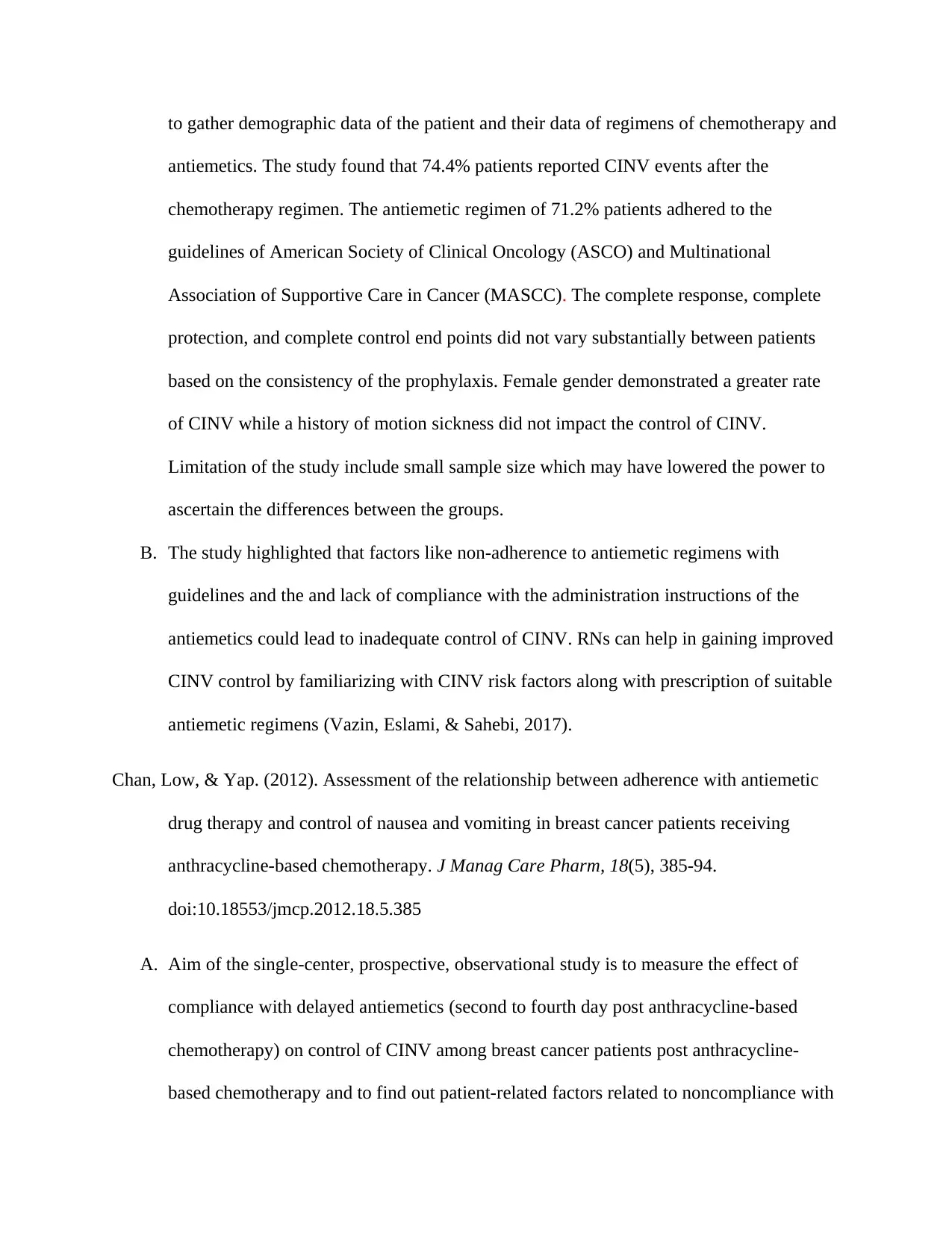
to gather demographic data of the patient and their data of regimens of chemotherapy and
antiemetics. The study found that 74.4% patients reported CINV events after the
chemotherapy regimen. The antiemetic regimen of 71.2% patients adhered to the
guidelines of American Society of Clinical Oncology (ASCO) and Multinational
Association of Supportive Care in Cancer (MASCC). The complete response, complete
protection, and complete control end points did not vary substantially between patients
based on the consistency of the prophylaxis. Female gender demonstrated a greater rate
of CINV while a history of motion sickness did not impact the control of CINV.
Limitation of the study include small sample size which may have lowered the power to
ascertain the differences between the groups.
B. The study highlighted that factors like non-adherence to antiemetic regimens with
guidelines and the and lack of compliance with the administration instructions of the
antiemetics could lead to inadequate control of CINV. RNs can help in gaining improved
CINV control by familiarizing with CINV risk factors along with prescription of suitable
antiemetic regimens (Vazin, Eslami, & Sahebi, 2017).
Chan, Low, & Yap. (2012). Assessment of the relationship between adherence with antiemetic
drug therapy and control of nausea and vomiting in breast cancer patients receiving
anthracycline-based chemotherapy. J Manag Care Pharm, 18(5), 385-94.
doi:10.18553/jmcp.2012.18.5.385
A. Aim of the single-center, prospective, observational study is to measure the effect of
compliance with delayed antiemetics (second to fourth day post anthracycline-based
chemotherapy) on control of CINV among breast cancer patients post anthracycline-
based chemotherapy and to find out patient-related factors related to noncompliance with
antiemetics. The study found that 74.4% patients reported CINV events after the
chemotherapy regimen. The antiemetic regimen of 71.2% patients adhered to the
guidelines of American Society of Clinical Oncology (ASCO) and Multinational
Association of Supportive Care in Cancer (MASCC). The complete response, complete
protection, and complete control end points did not vary substantially between patients
based on the consistency of the prophylaxis. Female gender demonstrated a greater rate
of CINV while a history of motion sickness did not impact the control of CINV.
Limitation of the study include small sample size which may have lowered the power to
ascertain the differences between the groups.
B. The study highlighted that factors like non-adherence to antiemetic regimens with
guidelines and the and lack of compliance with the administration instructions of the
antiemetics could lead to inadequate control of CINV. RNs can help in gaining improved
CINV control by familiarizing with CINV risk factors along with prescription of suitable
antiemetic regimens (Vazin, Eslami, & Sahebi, 2017).
Chan, Low, & Yap. (2012). Assessment of the relationship between adherence with antiemetic
drug therapy and control of nausea and vomiting in breast cancer patients receiving
anthracycline-based chemotherapy. J Manag Care Pharm, 18(5), 385-94.
doi:10.18553/jmcp.2012.18.5.385
A. Aim of the single-center, prospective, observational study is to measure the effect of
compliance with delayed antiemetics (second to fourth day post anthracycline-based
chemotherapy) on control of CINV among breast cancer patients post anthracycline-
based chemotherapy and to find out patient-related factors related to noncompliance with
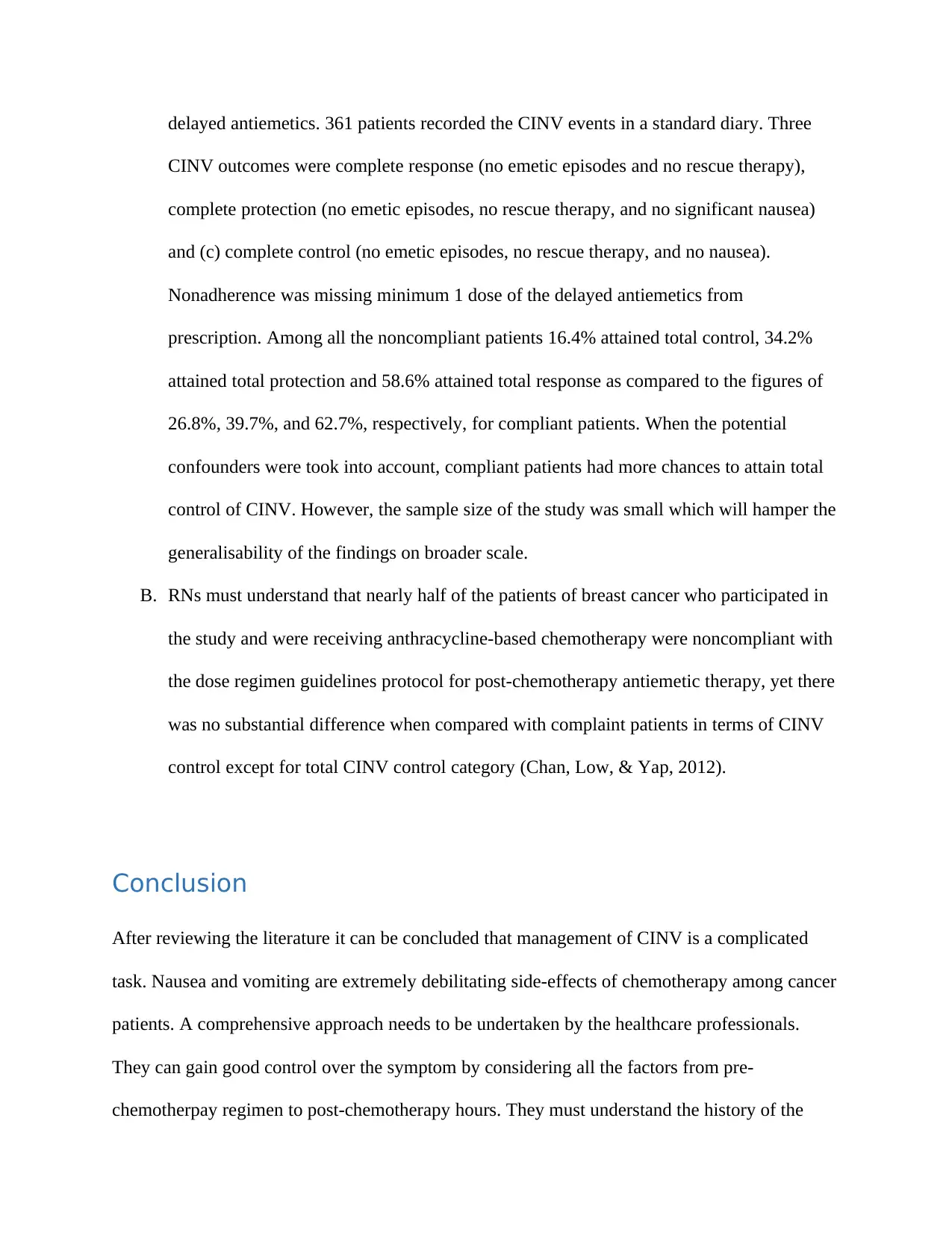
delayed antiemetics. 361 patients recorded the CINV events in a standard diary. Three
CINV outcomes were complete response (no emetic episodes and no rescue therapy),
complete protection (no emetic episodes, no rescue therapy, and no significant nausea)
and (c) complete control (no emetic episodes, no rescue therapy, and no nausea).
Nonadherence was missing minimum 1 dose of the delayed antiemetics from
prescription. Among all the noncompliant patients 16.4% attained total control, 34.2%
attained total protection and 58.6% attained total response as compared to the figures of
26.8%, 39.7%, and 62.7%, respectively, for compliant patients. When the potential
confounders were took into account, compliant patients had more chances to attain total
control of CINV. However, the sample size of the study was small which will hamper the
generalisability of the findings on broader scale.
B. RNs must understand that nearly half of the patients of breast cancer who participated in
the study and were receiving anthracycline-based chemotherapy were noncompliant with
the dose regimen guidelines protocol for post-chemotherapy antiemetic therapy, yet there
was no substantial difference when compared with complaint patients in terms of CINV
control except for total CINV control category (Chan, Low, & Yap, 2012).
Conclusion
After reviewing the literature it can be concluded that management of CINV is a complicated
task. Nausea and vomiting are extremely debilitating side-effects of chemotherapy among cancer
patients. A comprehensive approach needs to be undertaken by the healthcare professionals.
They can gain good control over the symptom by considering all the factors from pre-
chemotherpay regimen to post-chemotherapy hours. They must understand the history of the
CINV outcomes were complete response (no emetic episodes and no rescue therapy),
complete protection (no emetic episodes, no rescue therapy, and no significant nausea)
and (c) complete control (no emetic episodes, no rescue therapy, and no nausea).
Nonadherence was missing minimum 1 dose of the delayed antiemetics from
prescription. Among all the noncompliant patients 16.4% attained total control, 34.2%
attained total protection and 58.6% attained total response as compared to the figures of
26.8%, 39.7%, and 62.7%, respectively, for compliant patients. When the potential
confounders were took into account, compliant patients had more chances to attain total
control of CINV. However, the sample size of the study was small which will hamper the
generalisability of the findings on broader scale.
B. RNs must understand that nearly half of the patients of breast cancer who participated in
the study and were receiving anthracycline-based chemotherapy were noncompliant with
the dose regimen guidelines protocol for post-chemotherapy antiemetic therapy, yet there
was no substantial difference when compared with complaint patients in terms of CINV
control except for total CINV control category (Chan, Low, & Yap, 2012).
Conclusion
After reviewing the literature it can be concluded that management of CINV is a complicated
task. Nausea and vomiting are extremely debilitating side-effects of chemotherapy among cancer
patients. A comprehensive approach needs to be undertaken by the healthcare professionals.
They can gain good control over the symptom by considering all the factors from pre-
chemotherpay regimen to post-chemotherapy hours. They must understand the history of the
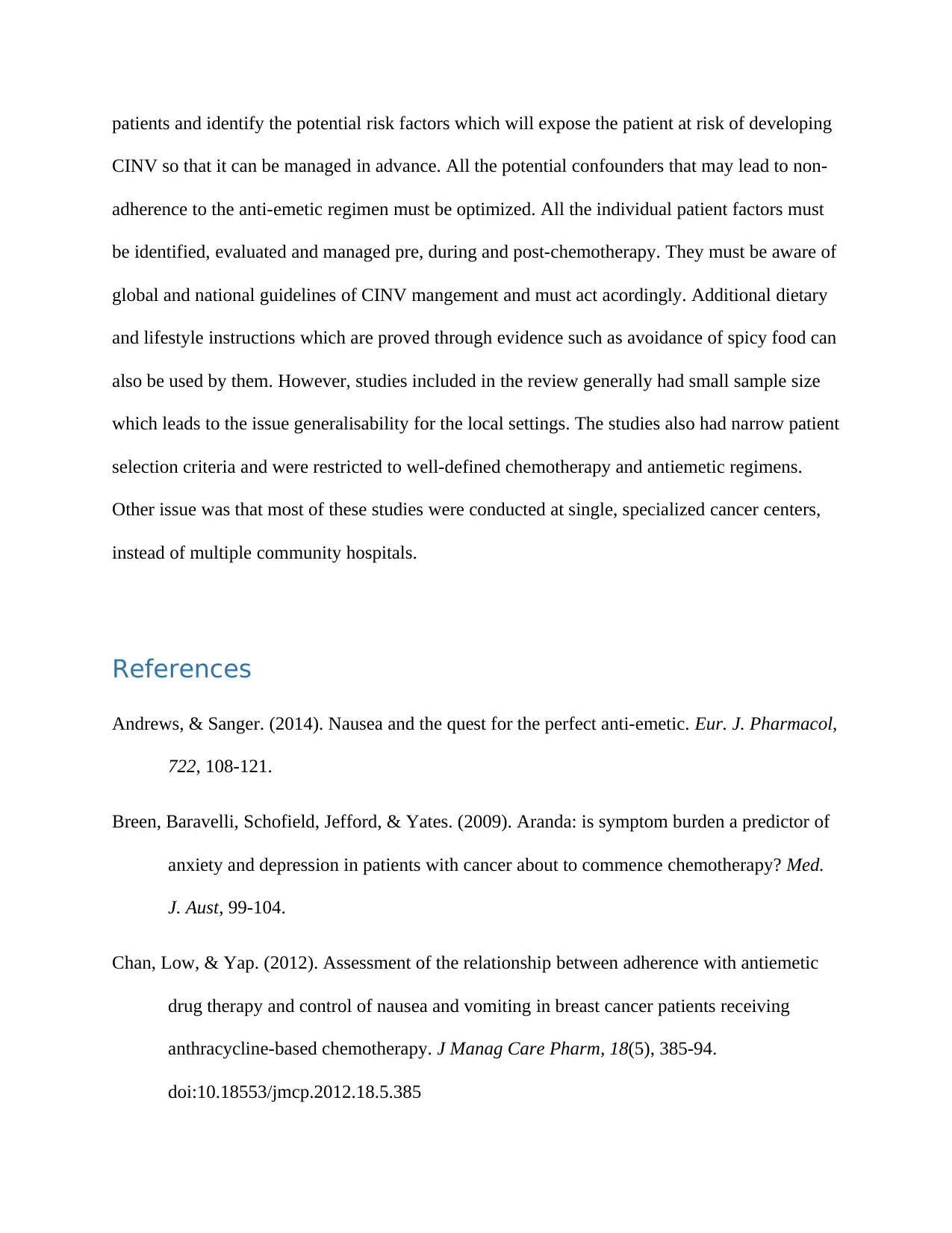
patients and identify the potential risk factors which will expose the patient at risk of developing
CINV so that it can be managed in advance. All the potential confounders that may lead to non-
adherence to the anti-emetic regimen must be optimized. All the individual patient factors must
be identified, evaluated and managed pre, during and post-chemotherapy. They must be aware of
global and national guidelines of CINV mangement and must act acordingly. Additional dietary
and lifestyle instructions which are proved through evidence such as avoidance of spicy food can
also be used by them. However, studies included in the review generally had small sample size
which leads to the issue generalisability for the local settings. The studies also had narrow patient
selection criteria and were restricted to well-defined chemotherapy and antiemetic regimens.
Other issue was that most of these studies were conducted at single, specialized cancer centers,
instead of multiple community hospitals.
References
Andrews, & Sanger. (2014). Nausea and the quest for the perfect anti-emetic. Eur. J. Pharmacol,
722, 108-121.
Breen, Baravelli, Schofield, Jefford, & Yates. (2009). Aranda: is symptom burden a predictor of
anxiety and depression in patients with cancer about to commence chemotherapy? Med.
J. Aust, 99-104.
Chan, Low, & Yap. (2012). Assessment of the relationship between adherence with antiemetic
drug therapy and control of nausea and vomiting in breast cancer patients receiving
anthracycline-based chemotherapy. J Manag Care Pharm, 18(5), 385-94.
doi:10.18553/jmcp.2012.18.5.385
CINV so that it can be managed in advance. All the potential confounders that may lead to non-
adherence to the anti-emetic regimen must be optimized. All the individual patient factors must
be identified, evaluated and managed pre, during and post-chemotherapy. They must be aware of
global and national guidelines of CINV mangement and must act acordingly. Additional dietary
and lifestyle instructions which are proved through evidence such as avoidance of spicy food can
also be used by them. However, studies included in the review generally had small sample size
which leads to the issue generalisability for the local settings. The studies also had narrow patient
selection criteria and were restricted to well-defined chemotherapy and antiemetic regimens.
Other issue was that most of these studies were conducted at single, specialized cancer centers,
instead of multiple community hospitals.
References
Andrews, & Sanger. (2014). Nausea and the quest for the perfect anti-emetic. Eur. J. Pharmacol,
722, 108-121.
Breen, Baravelli, Schofield, Jefford, & Yates. (2009). Aranda: is symptom burden a predictor of
anxiety and depression in patients with cancer about to commence chemotherapy? Med.
J. Aust, 99-104.
Chan, Low, & Yap. (2012). Assessment of the relationship between adherence with antiemetic
drug therapy and control of nausea and vomiting in breast cancer patients receiving
anthracycline-based chemotherapy. J Manag Care Pharm, 18(5), 385-94.
doi:10.18553/jmcp.2012.18.5.385
Secure Best Marks with AI Grader
Need help grading? Try our AI Grader for instant feedback on your assignments.
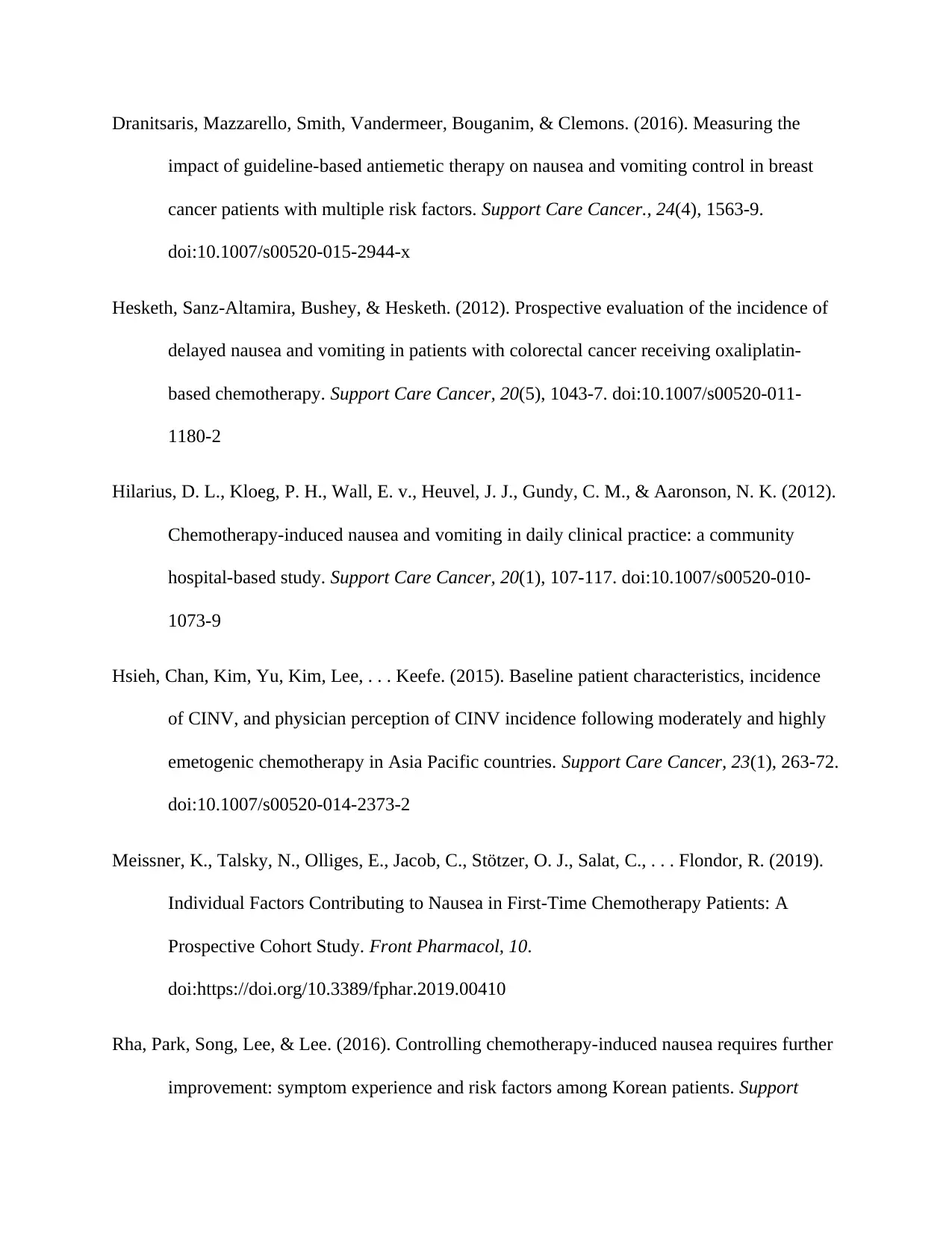
Dranitsaris, Mazzarello, Smith, Vandermeer, Bouganim, & Clemons. (2016). Measuring the
impact of guideline-based antiemetic therapy on nausea and vomiting control in breast
cancer patients with multiple risk factors. Support Care Cancer., 24(4), 1563-9.
doi:10.1007/s00520-015-2944-x
Hesketh, Sanz-Altamira, Bushey, & Hesketh. (2012). Prospective evaluation of the incidence of
delayed nausea and vomiting in patients with colorectal cancer receiving oxaliplatin-
based chemotherapy. Support Care Cancer, 20(5), 1043-7. doi:10.1007/s00520-011-
1180-2
Hilarius, D. L., Kloeg, P. H., Wall, E. v., Heuvel, J. J., Gundy, C. M., & Aaronson, N. K. (2012).
Chemotherapy-induced nausea and vomiting in daily clinical practice: a community
hospital-based study. Support Care Cancer, 20(1), 107-117. doi:10.1007/s00520-010-
1073-9
Hsieh, Chan, Kim, Yu, Kim, Lee, . . . Keefe. (2015). Baseline patient characteristics, incidence
of CINV, and physician perception of CINV incidence following moderately and highly
emetogenic chemotherapy in Asia Pacific countries. Support Care Cancer, 23(1), 263-72.
doi:10.1007/s00520-014-2373-2
Meissner, K., Talsky, N., Olliges, E., Jacob, C., Stötzer, O. J., Salat, C., . . . Flondor, R. (2019).
Individual Factors Contributing to Nausea in First-Time Chemotherapy Patients: A
Prospective Cohort Study. Front Pharmacol, 10.
doi:https://doi.org/10.3389/fphar.2019.00410
Rha, Park, Song, Lee, & Lee. (2016). Controlling chemotherapy-induced nausea requires further
improvement: symptom experience and risk factors among Korean patients. Support
impact of guideline-based antiemetic therapy on nausea and vomiting control in breast
cancer patients with multiple risk factors. Support Care Cancer., 24(4), 1563-9.
doi:10.1007/s00520-015-2944-x
Hesketh, Sanz-Altamira, Bushey, & Hesketh. (2012). Prospective evaluation of the incidence of
delayed nausea and vomiting in patients with colorectal cancer receiving oxaliplatin-
based chemotherapy. Support Care Cancer, 20(5), 1043-7. doi:10.1007/s00520-011-
1180-2
Hilarius, D. L., Kloeg, P. H., Wall, E. v., Heuvel, J. J., Gundy, C. M., & Aaronson, N. K. (2012).
Chemotherapy-induced nausea and vomiting in daily clinical practice: a community
hospital-based study. Support Care Cancer, 20(1), 107-117. doi:10.1007/s00520-010-
1073-9
Hsieh, Chan, Kim, Yu, Kim, Lee, . . . Keefe. (2015). Baseline patient characteristics, incidence
of CINV, and physician perception of CINV incidence following moderately and highly
emetogenic chemotherapy in Asia Pacific countries. Support Care Cancer, 23(1), 263-72.
doi:10.1007/s00520-014-2373-2
Meissner, K., Talsky, N., Olliges, E., Jacob, C., Stötzer, O. J., Salat, C., . . . Flondor, R. (2019).
Individual Factors Contributing to Nausea in First-Time Chemotherapy Patients: A
Prospective Cohort Study. Front Pharmacol, 10.
doi:https://doi.org/10.3389/fphar.2019.00410
Rha, Park, Song, Lee, & Lee. (2016). Controlling chemotherapy-induced nausea requires further
improvement: symptom experience and risk factors among Korean patients. Support
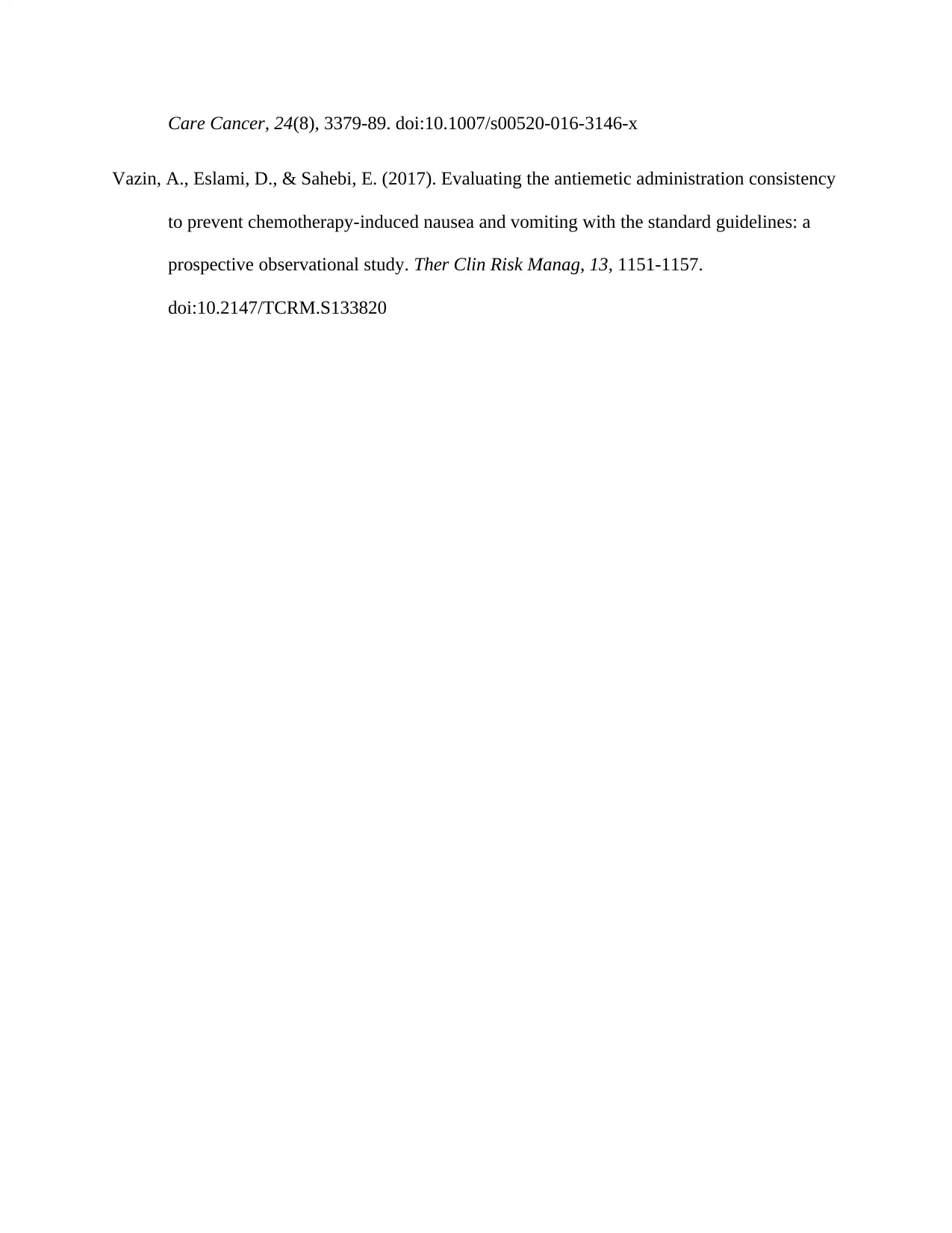
Care Cancer, 24(8), 3379-89. doi:10.1007/s00520-016-3146-x
Vazin, A., Eslami, D., & Sahebi, E. (2017). Evaluating the antiemetic administration consistency
to prevent chemotherapy-induced nausea and vomiting with the standard guidelines: a
prospective observational study. Ther Clin Risk Manag, 13, 1151-1157.
doi:10.2147/TCRM.S133820
Vazin, A., Eslami, D., & Sahebi, E. (2017). Evaluating the antiemetic administration consistency
to prevent chemotherapy-induced nausea and vomiting with the standard guidelines: a
prospective observational study. Ther Clin Risk Manag, 13, 1151-1157.
doi:10.2147/TCRM.S133820
1 out of 12
Related Documents
Your All-in-One AI-Powered Toolkit for Academic Success.
+13062052269
info@desklib.com
Available 24*7 on WhatsApp / Email
![[object Object]](/_next/static/media/star-bottom.7253800d.svg)
Unlock your academic potential
© 2024 | Zucol Services PVT LTD | All rights reserved.





